Back in 2007, Mötley Crüe was celebrating the 20th anniversary of their album “Girls, Girls, Girls.” ED Publications, in turn, celebrated the most popular song in the history of the strip club industry—you guessed it, “Girls, Girls, Girls.” That’s why the Crue landed on the cover of our July 2007 issue, which was accompanied by an in-depth look into the song that helped define an entire industry. It’s also why, that same year, we decided to induct Mötley Crüe into our (ED Publications’) Hall of Fame at our Annual Adult Nightclub & Exotic Dancer Awards Show in Las Vegas (Vince Neil was on hand to accept).
We were fortunate enough to feature exclusive interviews with Vince Neil and Nikki Sixx in our July 2007 issue’s cover story, who both shared their recollections of writing that song and how they’ve seen its place in the strip club industry evolve over the decades.
As their recently-released Netflix biopic “The Dirt” (based upon the book of the same name) is garnering a ton of buzz (read our review here), we’ve decided to take a look back at that story and the detailed history of a song that arrived at a key time in the club industry, as the old-school strip clubs were about to evolve into the “gentlemen’s-club” era of the 1990 and beyond.

Motley Crue’s “Girls, Girls, Girls”
Vince Neil and Nikki Sixx reveal the story behind the most popular strip club song ever
- story by Dave Manack

For over 20 years, there was a song played at virtually every strip club in the country. And you know the song well—the motorcycle revs its engine, the guitar comes roaring in, and the memorable melody boldly announces that the party has just begun. It’s “Girls, Girls, Girls,” and for over three decades, it’s served as an anthem for thousands of strip clubs across the U.S. and around the world.
“I’ve always been a big fan of strip clubs, so for us, that was just a really fun song to write,” says Mötley Crüe’s vocalist Vince Neil. “When we wrote ‘Girls, Girls, Girls,’ it expressed our feelings for the (strip club) industry. The song is just a good-time song; it’s all about rock n’ roll, motorcycles, drinking … it epitomized that particular time in our lives.”
“The girls, the music, the motorcycles, that’s just what we did. I remember at the time, I never used to see other musicians hanging out in strip clubs, it was just us. But it was funny—as soon as the song took off, it became a lifestyle for other rock musicians as well.” – Nikki Sixx
“’Girls, Girls, Girls’ is a lifestyle song; it’s who we were and what we were doing during the era that the song was written,” echoes Mötley Crüe bassist and chief songwriter Nikki Sixx. “During that era, we were a gang of guys and strip clubs became the place for us to socialize. [The legendary Crüe lineup also consists of drummer Tommy Lee and guitarist Mick Mars.] The girls, the music, the motorcycles, that’s just what we did. I remember at the time, I never used to see other musicians hanging out in strip clubs, it was just us. But it was funny—as soon as the song took off, it became a lifestyle for other rock musicians as well.”

The Girls, Girls, Girls album was released on May 15, 1987, and included an official record release party at the Body Shop strip club on Sunset Boulevard in Hollywood. It was certainly a fitting venue, considering that the Body Shop was one of six North American adult nightclubs—including Thee Dollhouse in Fort Lauderdale, Tattletales in Atlanta, the Marble Arch in Vancouver (British Columbia, Canada), and two other Sunset Boulevard clubs, the Seventh Veil and the Tropicana—that are mentioned directly in the lyrics. For those who were fortunate enough to be mentioned, “Girls, Girls, Girls” became a badge of honor. Which leads to an obvious question: Why were these adult clubs chosen out of all the clubs in North America?
“When we were writing ‘Girls, Girls, Girls,’ we wrote down a few of the clubs we remembered, some that were favorites of ours,” Neil recalls. “But they also had to have a name that sounded cool and fit into the flow of the song. So not all of the clubs we loved made it. But it would always be great when we went back to those clubs or to the cities that we mentioned in the song—they really loved the song because of it.”
How “Girls, Girls, Girls” became the strip clubs’ anthem
Though “stripper” and club-oriented songs may be a-dime-a-dozen now, they weren’t in 1987. In fact, they were nowhere to be found. That is until four long-haired, hard-partying rockers from Hollywood decided to devote not just a song, but also the name of their fourth studio album to the beautiful women that danced at adult clubs and the lifestyle that the clubs evoked. As Neil explains, however, there were other album titles that circulated prior to its release.
“It was really cool for Michael (Peter) to start that trend of bringing all of the girls up on stage every hour and playing the song [the concept known as ‘uptime,’ a feature that became the norm at clubs—Ed.]. (The song) ’Girls, Girls, Girls’ would not have been as popular as it became without Michael doing that in his clubs every night, every hour on the hour.” – Vince Neil
“At the time, we weren’t even sure we were going to call the album Girls, Girls, Girls,” Neil recalls. “But I liked the album title so much that I actually had it tattooed on my arm. I knew if I did that, they’d have a hard time changing it!”

Upon its release, the Girls, Girls, Girls LP helped the band’s popularity skyrocket. With a sexy video in tow (shot at such clubs as the Seventh Veil and Thee Dollhouse), the “Girls, Girls, Girls” single helped the album sell several million copies worldwide, achieving multi-platinum status in the U.S. But as Neil points out, the song—and album—would not have achieved its legendary status had it not been for the adult nightclubs around the country that helped catapult the song to #12 on the Billboard charts and the album all the way to #2. The greatest example of this, Neil notes, was the trend set by his good friend Michael J. Peter, a club owner/operator who is known by many to be the forerunner of the modern-day gentlemen’s club.
“It was really cool for Michael to start that trend of bringing all of the girls up on stage every hour and playing the song [the concept known as “uptime,” a feature practiced by a majority of adult clubs—Ed.],” says Neil who, along with the rest of Mötley Crüe, met Peter during the recording of Girls, Girls, Girls. “(The song) ’Girls, Girls, Girls’ would not have been as popular as it became without Michael doing that in his clubs every night, every hour on the hour.”
For Mötley Crüe, there was no doubt that “Girls, Girls, Girls”—along with “Home Sweet Home”—had become one of the biggest hits of their career up to that point. But according to Sixx, it wasn’t until several years later that the band realized the song’s impact on adult nightclubs—that it had, in fact, become the industry’s anthem.
“I don’t think the popularity of ‘Girls, Girls, Girls’ [in the adult club industry] really hit any of us until about 10 years later, when we were in a strip club and they’d parade the girls out to it,” says Sixx. “It was then that I realized that it wasn’t as much our song as it was (the strip club industry’s) song. It’s sort of like Bob Seger’s ‘Like a Rock’ and Chevy trucks—they became synonymous with each other. It’s amazing when something takes on a life of its own like ‘Girls, Girls, Girls’ has.”
A song, a band, a legacy … and every now and then, a dose of anonymity
Sometimes when successful bands pen classic tunes, they feel chained to that song for the rest of their careers, obliged to play it each night for demanding crowds. Not so for the Crüe and “Girls, Girls, Girls,” at least according to Neil and Sixx. While Neil jokes that his tombstone will someday read, “Here lies Vince Neil, the guy who wrote ‘Girls, Girls, Girls,’” it was his favorite song in Mötley Crüe’s impressive live set, a set that drew from eight studio albums and 30 years of music.
(See Vince Neil at the four-minute mark discussing their induction into the ED Hall of Fame)
“I still love to sing that song, especially because of the audience’s reaction to it,” says Neil. “No matter what country we’re in, everybody is singing along. They know all the words, they know the names of all of the clubs. If we didn’t do that song at one of our shows, there’d be some pretty pissed off people!”
“I don’t think the popularity of ‘Girls, Girls, Girls’ [in the strip club industry] really hit any of us until about 10 years later, when we were in a strip club and they’d parade the girls out to it. It was then that I realized that it wasn’t as much our song as it was your song.” – Nikki Sixx
For Sixx, the song still represents a chapter in his storied past when a great time was just a Harley ride away.
“Drinking, looking for girls, riding our motorcycles … those were some of the greatest times of my life,” Sixx reminisces. “Back then, I could get into a fight, then get a kiss from a girl and a shot of whisky—and there was no threat of litigation to be found. Now, everything is so rule-oriented. During the time we passed through, everything was much more free-spirited.”

It almost sounds as if Sixx longs for the rough and tumble strip clubs of yesteryear, well before they resembled anything close to a “gentlemen’s club.” Not so, says Sixx, who admires today’s adult nightclub industry for its growth, grandiose presentation and, of course, the modern exotic dancer.
“Thanks to Michael (Peter), the clubs are a lot more expensive now. The days of the $5 lap dance are long gone! But it is nice to go into a gentlemen’s club and have a nice meal in an upscale place, yet still have fun.” – Vince Neil
“Now, you can go to a gentlemen’s club and get a good meal; the environment is upscale, they have incredible lighting and amazing sound, and everything is top notch,” says Sixx. “And the entertainers are 1,000-times better now. They know how to dance, they know how to socialize—they do it all better now. Compared to 20 years ago, the quality of girls now is just amazing. The dancers now are on top of their game.”
“And thanks to Michael (Peter), the clubs are a lot more expensive now,” Neil adds with a laugh. “The days of the $5 lap dance are long gone! But it is nice to go into a gentlemen’s club and have a nice meal in an upscale place, yet still have fun.”
You’d think that penning the industry’s anthem would gain Mötley Crüe instant recognition at strip clubs in all corners of the globe. As Sixx boasts proudly, “I’ve been to every type of club that you can imagine in just about every country in the world—from underground clubs in Europe to high-end gentlemen’s clubs—and everywhere I go, I still hear that song.” So, of course, they’d have that universal recognition … right?
“The dancers are obviously much younger now; some of these girls weren’t even born when ‘Girls, Girls, Girls’ came out,” says Neil. “Sometimes when I’m at a club a dancer will meet me and say, ‘So what band are you in?’ I say, ‘Mötley Crüe.’ Then there’s a pause … she says, ‘Who?’ ‘We do the song ‘Girls, Girls, Girls.’ She says, ‘Oh, I know that song! That’s you guys?!’ And I can’t help but laugh.”
































[…] Vince Neil & Nikki Sixx talk “Girls, Girls, Girls” […]